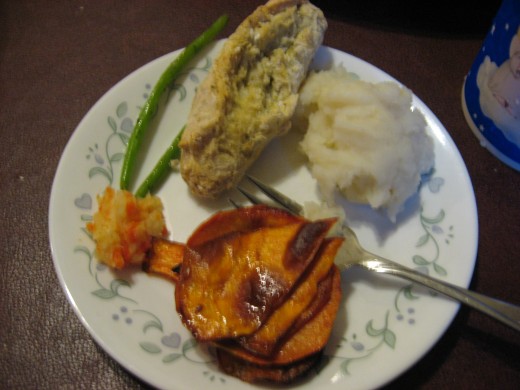Don't Clean That Plate! Instilling Healthy Eating Habits For Kids (and Grown Ups, too)

Despite Grandma's dire admonishments, the fate of starving children in Africa, China, Ethiopia or any third world area are not in the hands of picky eaters anywhere. Polishing off that plate of leftovers is not going to save anyone any money. And forcing a child to eat more than is comfortable can actually do a lot more harm than good.
In fact, experts no longer feel there is any good to be had from turning food into a mealtime battle. The clean plate rule leads to indigestion, late night stomach aches, and whiny kids. It can lead to obesity and related health problems. It also sets the stage for eating disorders in the adolescent population, when kids are old enough to want to exert some control over their lives and find that fighting rules like "Clean your plate before you leave the table," put them in a position of relative power.
Young children often seem to exist on nothing but air and questions. Distraught parents institute various rules surrounding food in an attempt to keep their children satiated and eating healthfully. But when you hear parents yelling "You will finish that pizza or you won't play on the playground at all!" it's time to reassess.
Food is important. It's essential to fuel young bodies with enough nutrients to both keep them moving and to grow healthy bones and brains. Kids innately know that they need nourishment. It's us grown ups who throw a wrench in nature's design by introducing fried foods, sugary cereals and empty calories; skewing a child's cravings by setting their taste buds at odds with their under developed common sense. And then we confuse things further with silly rules like cleaning your plate or bribing them with food.
After all, as important as it is, food is also fun. It's the building block of most gatherings, the social tie that binds many of us, and it's a terrific ice breaker. We get together for appetizers and meet up for dessert. We reward ourselves with ice cream; and our kids with lollipops when they manage to politely navigate their way through a doctor's appointment.
Food or Foe: Healthy Eating Habits
At the first bite of solid food, kids begin to develop lifelong eating habits and attitudes. That's why parenting manuals suggest a relaxed atmosphere, and offering plenty of fruits and vegetables without sauces, sweeteners or salt.
Then, somewhere between the second and third birthday, there is a push to eat 'what adults eat'. Cookies, crackers, chips and fast food start to take center stage. As kids learn to reason, adults begin to make bargains with them. Eat all your dinner and you will get dessert. Sit still for your vaccine and we'll go out for ice cream. If you'll just cooperate while we're running errands, we can go out for pizza.
Sometimes, it seems like naughty kids will be relegated to broccoli laden feasts for eternity while the good kids will lie in bed with junk food induced tummy aches. It's ironic that physical discomfort is the consequence for a 'reward'. What's more, is that many of the desserts are rewards dependant upon not only good behavior, but cleaning a plate. Once the 'good food' (defined as savory) is gone, the theory is that kids will only eat as much dessert as their tummies are really hungry for. But in reality, they want the supersized serving. They worry that if they don't eat it now, they won't get some later. After all, not everyone can be good for the rest of eternity. And their plate has to be emptied. Don't the same rules apply to dessert?
Rules about eating lead to confused eating habits in the adult years. Although parents tend to mean well, trying to institute rules that ensure nourishing food gets eaten before the fun food is accessed, these rules often backfire. Terms like 'good food' are ambiguous to kids. Unfortunately, they sometimes get confused by parents, too.
It's essential to eat a good breakfast before school (or work). But many parents will let a poptart or donut suffice. While yogurt is a better choice, many child-oriented choices happen to have as much sugar as a pastry. Healthy eating habits are so much more than the quantities and proportions of your meals.
Attitude is an issue that is often ignored by parents but not by their kids. Every time a parent jokes about applying that Halloween candy straight to their thighs, or complains about the calories in their dinner, kids are listening. They are absorbing this information and filing it away.
Why Eat at the Table?
Eating at the table builds healthy eating habits. When you eat on the run or in front of the TV, your brain forgets to signal that you're full. Your taste buds miss the full experience of your meal. And it's more likely to lead to indigestion. By eating at a table, you're not only improving your own digestion, you're teaching your kids that it's important to spend quality time together. You're demonstrating that good food and mealtimes are valuable to you. After all, you sit together to eat ice cream at the ice cream shop. You should value real meals at least that much.

Better Food Rules
Since your child's attitudes about food are shaped early on, it's important to examine your own food rules. What sort of message are they sending? If you struggle with weight issues, or have a love/hate relationship with food, you already know how important food rules and attitudes are.
Don't make the dinner table a battlefield. It'll just cause both you and your kids to overeat, probably the wrong items. When you serve a meal, simply expect your child to come to the table and be polite. Hungry kids eat. (If you know your child is hungry and is still not eating or not eating enough, there is something else going on that needs to be investigated. But enforcing a clean plate rule won't fix it.) Arguing with your child simply helps give them leverage, so decide beforehand what your rules are. Many families allow a second choice snack of sandwich or cereal if the child sits at the table and politely participates in mealtime conversation. Often as the child participates, they'll begin snacking on the dish in front of them, knowing that 'their meal' is still forthcoming at the end of the meal. If you don't comment on it, they might not even remember that they hate peas and carrots, or mashed potatoes, or roasted chicken instead of fried.
Of course, in today's society, a lot of families don't actually sit down to eat together. Change that habit immediately. Even if you're making frozen lasagne for dinner, you can make the family sized dish, and let whoever is home come to the table and eat together. It sets a good precedent for everyone.
Snacking in between meals used to be frowned upon. Then 'grazing' became encouraged. Now, single serving packages are sold to try and help consumers restrict their snack serving sizes. Rather than worry about snacking, make sure that the right snacks are available. When you're making dinner, or during homework time, or whenever people start congregating in the kitchen, stick a platter of pre-cut veggies or fruit and a semi healthy dip out on the table. Make the junk food more difficult to get to. (Maybe hide it out in the garage storage area) If your kids spent the afternoon snacking on carrot sticks and radishes, you don't have to worry when they don't want to eat their broccoli at dinner time.
Clarify the word "good". Kids hear adults complimenting the host with phrases like "Oh, this cake is so good!" Then they are told to hurry up and eat some good food so they can have dessert. Well, which is it? Good savory items, or good tasty items? Discuss foods that make tummies happy (healthy fruits, vegetables and legumes) and foods that make our tongues happy (fried, salty or sugary sweet)
Healthy Habits Last a Lifetime
You don't have to follow perfect rules all the time. By eating at a table 5 days out of the week, you're still setting the precedent that meals are important to you. By eating in more than half the time, you are demonstrating to your kids that nutrition matters.
If you go overboard with restrictions that make kids feel isolated or as if they are permanently deprived, then your best intentions will backfire. Unless there are extenuating medical conditions, there needs to be exceptions for slivers of chocolate cake, a surprise cookie in a lunchbox, and other delicacies. The problems only arise when kids overeat on those items. Make sure that they are offered a variety of fruits and vegetables, and that the available junk food is minimized.
You won't just be setting a good example for your kids. You'll be resetting your own healthy eating habits towards healthier lifestyle management. Which means, you'll enjoy better health in the long run. Something that will come in handy for a lifetime.








